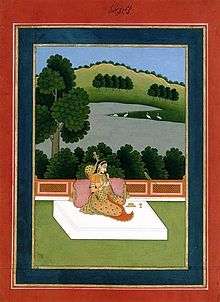Alivardi Khan
Alivardi Khan (Bengali: আলীবর্দী খান, romanized: Alibordi Khan, Persian: على وردي خان; 1671 – 9 April 1756) was the Nawab of Bengal from 1740 to 1756. He toppled the Nasiri Dynasty of the Nawabs and took powers of the Nawab. He is also one of the few Mughal-era leaders known for his victory during the Battle of Burdwan against the Maratha Empire during the Maratha invasions of Bengal.
Alivardi Khan | |
|---|---|
| Shuja ul-Mulk (Hero of the country) Hashim ud-Daula (Sword of the state) Mahabat Jang (Horror in War) | |
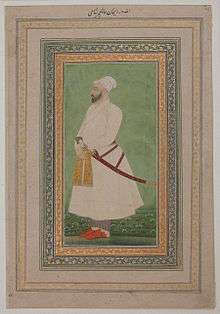 | |
| 4th Nawab Nazim of Bengal,Bihar and Orissa | |
| Reign | 29 April 1740 – 9 April 1756 |
| Predecessor | Sarfaraz Khan |
| Successor | Siraj ud-Daulah |
| Full name
Mirza Muhammad Ali (Alivardi Khan / Alahvirdi Khan) | |
| Native name | আলীবর্দী খান |
| Born | Before 10 May 1671 Deccan |
| Died | 10 April 1756 (aged 84) Murshidabad |
| Buried | Khushbagh, Murshidabad |
| Noble family | Afshar |
| Spouse(s) | Sharf-un-Nisa (sister of Sayyid Ahmed Najafi and daughter of Sayyid Hussain Najafi) |
| Issue | |
| Father | Shah Quli Khan (Mirza Muhammad Madani) |
| Mother | A daughter of Nawab Aqil Khan Afshar (Mir Muhammad Askari) |
| Religion | Shia Islam[1][2][3] |
| Military career | |
| Allegiance | Mughal Empire |
| Service/ | Nawab of Bengal |
| Rank | Subadar |
| Battles/wars | Nader Shah's invasion of the Mughal Empire, Mughal-Maratha Wars |
Early life
Alivardi Khan's father was Shah Quli Khan (Mirza Muhammad Madani) and his mother was the daughter of Nawab Aqil Khan Afshar (Mir Muhammad Askari). Alivardi's birth name was Mirza Muhammad Ali.His father was employee of Azam Shah, the son of Mughal Emperor Aurangzeb. Azam Shah also employed the sons of Mirza Muhammad. But after the death of Azam Shah, the family fell into poverty. His two sons Muhammad Ali and Mirza Ahmed managed to find employment under the Subahdar (Provincial governor) of Orissa, Shuja-ud-Din Muhammad Khan. After Shuja-ud-Din was promoted to the post of the Nawab of Bengal, the two brothers' future prospects widened.
Rise to power
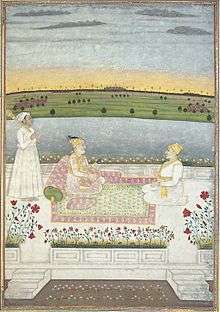
In 1728, Shuja-ud-Din promoted Muhammad Ali to Faujdar (General) of Rajmahal and entitled him as Alivardi Khan.[4] In 1733, he was assigned as the Naib Nazim (Deputy Subahdar) of Bihar. A year later he was titled Shuja ul-Mulk (Hero of the country), Hassemm ud-Daula (Sword of the state) and Mahabat Jang (Horror in War) and the rank of Paach Hazari Mansabdar (The rank holder of 5000) by Nawab Shuja ud-Din and returned to Azimabad.
Alivardi Khan aspired for larger authority. On 10 April 1740 in the Battle of Giria, he defeated and killed Shuja ud-Din's successor, Sarfaraz Khan.[4] Thus he took control of Bengal and Bihar. Then on 3 March 1741 he defeated Rustam Jang, deputy governor of Orissa and a relative of Sarfaraz Khan, in the battle of Phulwarion.[4] Orissa also came under control of Alivardi Khan.
Reign
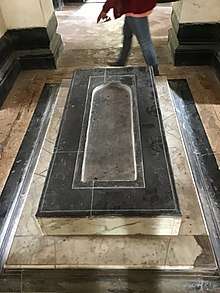
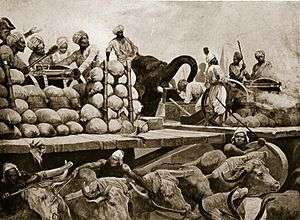
Immediately after his usurpation of power, Alivardi Khan had his takeover legitimized by the Mughal Emperor [Muhammad Shah] and resumed the policies of Murshid Quli Khan. Although he was the Nawab of Bengal he also used titles such as Nizam, he also chose Faujdars from various regions such as Patna, Dacca and Orissa.[5]
Since 1742, the Maratha Empire raided Bengal repeatedly ravaging its territories, and Alivardi Khan had almost immediately a long ditch, called the Maratha ditch, dug around Calcutta. Alivardi Khan was a brilliant artillery tactician, however, his armies were overrun by the large force of the Marathas from Berar who had arrived to pillage and plunder the territories of Bengal, under the commands of Raghoji I Bhonsle.
In the year 1747, the Marathas led by Raghoji, began to raid, pillage and annex the territories of the Alivardi Khan. During the Maratha invasion of Orissa, its Subedar Mir Jafar completely withdrew all forces until the arrival of Alivardi Khan and the Mughal Army at the Battle of Burdwan where Raghoji and his Maratha forces were completely routed. The enraged Alivardi Khan then dismissed the shamed Mir Jafar.[6]
Alivardi Khan's defending armies were overrun in Orissa in the year 1751, despite receiving some assistance from Shuja-ud-Daula. But Orissa was ultimately surrendered to the ravaging Marathas by the Mughal Emperor Ahmad Shah Bahadur. These Maratha raids would continue until 1751, when a peace-treaty was settled between Ahmad Shah Bahadur, Alivardi Khan and Raghoji.[4]
Alivardi Khan also subdued the revolt of a few unruly Afghans who were trying to separate Bihar from his administration.[4]
According to some historians Alivardi Khan reign of 16 years, was mostly engaged in various wars against the Marathas. Towards the end, he turned his attention to rebuilding and restoring Bengal.
Battle of Burdwan
| Battle of Burdwan | |||||||
|---|---|---|---|---|---|---|---|
| Part of Maratha invasions of Bengal | |||||||
| |||||||
| Belligerents | |||||||
|
|
| ||||||
| Commanders and leaders | |||||||
|
Alivardi Khan Umar Khan Mohmand Mustafa Khan Bahadur Musaib Khan Mohmand (KIA) | Janoji Bhonsle | ||||||
| Strength | |||||||
| 10,000+ infantry, cavalry and elephant-force | ~40,000 cavalry | ||||||
| Casualties and losses | |||||||
| unknown | heavy | ||||||
The Battle of Burdwan was a major confrontation between the Mughal Empire's Nawab of Bengal, Alivardi Khan and his invading Maratha opponents Janoji Bhonsle and Bhaskar Pandit. The battle concluded with a victory for the Nawab of Bengal, Alivardi Khan who was accompanied throughout the campaign by his wife Nafisah Khanam.
In the year 1747, the Marathas led by Janoji Bhonsle, began to raid, pillage and annex the territories of the Nawab of Bengal, Alivardi Khan in Orissa. Syed Hidayat Ali Khan, the Faujdar in Behar, who was on an expedition to the hill-passes of Raingarh, that the Maratha cavalry numbering 40,000 had sacked the town of Midnapore and set granaries and villages ablaze.

During the Maratha invasion of Orissa, its Subedar Mir Jafar and other officials such as Ataullah Faujdar of Rajmahal completely withdrew all forces and without any resistance awaited the arrival of Alivardi Khan and the Mughal Army.
When the Nawab of Bengal, Alivardi Khan received letters warning of the approach of Maratha he was completely disillusioned by this unforeseen invasion, in fact some of his trusted advisors even began to blame their aligned companion Asaf Jah I, the Nizam of Hyderabad for utter negligence in the Deccan.
In order to counter the eminent threat Alivardi Khan rallied a Mughal Army of nearly 10,000 troops also consisting of conscripts such as Abyssinian Sailors and Georgian Qizilbash. Alivardi Khan then informed the Mughal Emperor Muhammad Shah of the invasion and rode ceaselessly for almost three days towards the ruins of Bardhaman where the Marathas established occupation.
Alivardi Khan is known to have introduced and placed his artillery on large movable platforms driven that were by Oxen.
After reaching the ruins of Bardhaman, Alivardi Khan's vanguard under the command of Musahib Khan Mohmand was completely overrun. The Howdah of Nafisah Khanam (the wife of Alivardi Khan) had been captured and the elephant named Landah was dragged towards the Maratha encampment. Unwilling to abandon his command over the vanguard Musahib Khan Mohmand son of Umar Khan Mohmand one of Alivardi Khans commanders, led what remained of the vanguard's Sowars, Mahauts and Sepoy in order to attack the pillagers. Although the Howdah of Nafisah Khanam had been liberated, Musahib Khan Mohmand and his troops however fell in battle, their courage was compared to that of Rostam by Alivardi Khan.
According to Ghulam Husain Tabatabai when Alivardi Khan was reunited with his wife Nafisah Khanam, his forces were completely surrounded by Marathas, who had entrenched themselves a various positions whilst Alivardi Khan's forces faced starvation. After carefully planning the battle ahead, Alivardi Khan brilliantly organized his forces by placing baggage trains in the center and artillery carriages around his army. Mustafa Khan Bahadur prepared his Sowars for assault. Saulat Jang had finally arrived from Murshidabad with reinforcements and provisions.
Alivaedi Khan then sent a baggage train containing fine carpets, silks and ewers into his opponents lines provoking the Maratha to gather and loot the baggage trains. This action had exposed the Marathas to Alivardi Khan's advancing artillery carriages. While Mustafa Khan Bahadur prepared his Sowars on the left and right flanks and completely routed Janoji Bhonsle and his remaining Maratha infantry.
very soon Haji Ahmad arrived with even more provisions and fodder for Alivardi Khan's forces.
The Alivardi Khan dismissed the shamed Mir Jafar at Murshidabad for not having done much.
Cultural and musical development
Alivardi Khan was a patron of various musical instruments such as the Veena and Khol drums. He also patronized many manuscripts of the Shahnameh.
Death and succession
Alivardi Khan died of dropsy on 10 April 1756 aged at least 80. His grandchild from daughters side, Siraj-ud-Daula, succeeded him in April 1756 at the age of 23. Alivardi Khan lies buried in Khushbagh.
See also
- Nawabs of Bengal
- List of rulers of Bengal
- History of Bengal
- History of Bangladesh
- History of India
- Shia Islam in India
References
- S. A. A. Rizvi, A Socio-Intellectual History of Isna Ashari Shi'is in India, Vol. 2, pp. 45–47, Mar'ifat Publishing House, Canberra (1986).
- K. K. Datta, Ali Vardi and His Times, ch. 4, University of Calcutta Press, (1939)
- Andreas Rieck, The Shias of Pakistan, p. 3, Oxford University Press, (2015).
- Shah, Mohammad (2012). "Alivardi Khan". In Islam, Sirajul; Jamal, Ahmed A. (eds.). Banglapedia: National Encyclopedia of Bangladesh (Second ed.). Asiatic Society of Bangladesh.
- Markovits, Claude (2004). A History of Modern India, 1480-1950. Anthem Press. pp. 194–. ISBN 978-1-84331-004-4.
- Jaques, Tony (2007). Dictionary of Battles and Sieges: A-E. Greenwood Publishing Group. pp. 137–. ISBN 978-0-313-33537-2.
Further reading
| Wikimedia Commons has media related to Alivardi Khan. |
- AliVardi Khan and his times, Author - K. K. Dutt
- Decisive Battle of India, G. B. Malleson, ISBN 81-7536-291-X, published by Books For All, 2002.
- A site dedicated to Alivardi Khan
- Aliverdi Khan in the Dictionary of Indian Biography
Alivardi Khan Born: Before 10 May 1671 Died: 10 April 1756 | ||
| Preceded by Sarfaraz Khan |
Nawab of Bengal 29 April 1740 – 9 April 1756 |
Succeeded by Siraj ud-Daulah |
